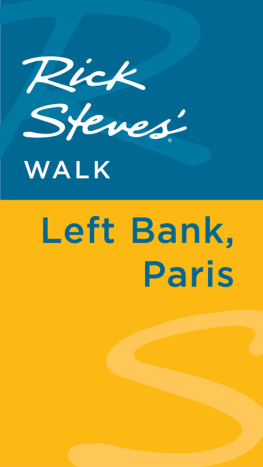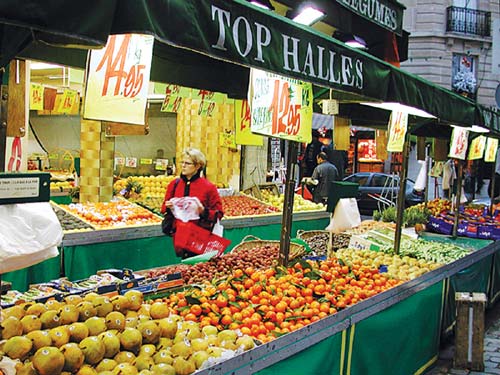Contents
Contents
Rick Steves Walk:
RUE CLER, PARIS
Rick Steves, Steve Smith & Gene Openshaw
Rue Cler Walk
The Art of Parisian Living
Paris is changing quickly, but a stroll down this open-air-market street introduces you to a thriving, traditional Parisian neighborhood and its local culture. Though somewhat upscale, Rue Cler retains the workaday charm of village Paris.
In food-crazy Paris, shopping for groceries is an integral part of everyday life. Rue Cler, traffic-free since 1984, is lined with the essential shopswine, cheese, bread, chocolateas well as a bank, a post office, and pleasant cafs.
To learn the fine art of living Parisian-style, theres no better classroom than Rue Cler. And you can assemble the ultimate French picnic. The Rue Cler Walk is the only tour in this guidebook you should start while hungry.
 Start your walk at the northern end of the pedestrian section of Rue Cler, at Rue de Grenelle (right by a bus #69 stop or a short walk from Mo: Ecole Militaire). Visit Rue Cler when its markets are open and lively (Tue-Sat 8:30-13:00 or 15:00-19:30, Sun 8:30-12:00, dead on Mon). Allow an hour to browse and caf-hop along this short, three-block walk.
Start your walk at the northern end of the pedestrian section of Rue Cler, at Rue de Grenelle (right by a bus #69 stop or a short walk from Mo: Ecole Militaire). Visit Rue Cler when its markets are open and lively (Tue-Sat 8:30-13:00 or 15:00-19:30, Sun 8:30-12:00, dead on Mon). Allow an hour to browse and caf-hop along this short, three-block walk.
This neighborhood fixture recently dumped its old-fashioned, characteristic look for the latest caf stylewarm, natural wood tones, easy lighting, and music. To the right of the door, youll see the Tarif des Consommations sign required by French law, making the pricing clear: Drinks served at the bar (comptoir) are cheaper than drinks served at the tables (salles). Inside, the bar is always busy. The blackboard lists wines sold by the little 7-centiliter glass (about 2.5 ounces), along with other drinks.
The little late-night grocery next door is one of countless corner shops nicknamed dpanneurs (to help you out of difficulty). Open nightly until midnight, these stores are often run by hardworking North Africans willing to keep long hours. Locals happily pay the higher prices for the convenience dpanneurs provide.
 If youre shopping for designer baby clothes, youll find them across the street at...
If youre shopping for designer baby clothes, youll find them across the street at...
The French spend at least as much on their babies as they do on their dogsdolling them up with designer jammies. This store is one in a popular chain. Babies-in-the-know just arent comfortable unless theyre making a fashion statement (such as underwear with sailor stripes). Whereas much of Europe faces an aging and shrinking population, France is having a baby booman average of two children per family, compared to 1.6 for the rest of Europe. Babies are trendy, and the government rewards parents with substantial tax deductions for their first two childrenand then doubles the deductions after that.
 Cross Rue de Grenelle to find...
Cross Rue de Grenelle to find...
Each morning, fresh produce is trucked in from farmers fields to Paris huge Rungis marketEuropes largest, near Orly Airportand then dispatched to merchants with FedEx-like speed and precision. Good luck finding a shopping baglocals bring their own two-wheeled carts or reusable bags. Also, notice how the earth-friendly French resist excessive packaging.
Parisians shop with their noses and buy foods in season. Try it. Sniff the odorless foreign strawberries (which locals call plastic strawberries), and compare with the odiferous torpedo-shaped French ones (garriguettes). Explore. Find the herbs in the backis todays delivery in? Check the melons and their country of originit must be posted. If theyre from Guadeloupe, theyre out of season, and many locals wont buy them.
The Franprix across the street is a small outpost of a nationwide supermarket chain. Opposite Grand Htel Lvque is Traiteur Asiatique. Fast Asian food to goabout as common as bakeries nowhas had an impact on traditional Parisian eating habits.
once-working-class market street is becoming increasingly upscale. Continue to...
French Etiquette
As you enter a shop, always greet the store owner with Bonjour, Madame (or Monsieur). If you really want to win a clerk over, follow up your greeting with Excusez-moi de vous dranger (ek-skew-zay-mwah duh voo day-rahn-zhay)Pardon me for bothering youthen ask for what you need. Remember that shopkeepers are busy serving regular customers, so dont get in the way. As you leave, complete the social interaction with Au revoir, Madame (or Monsieur).
On your walk, youll likely see Parisian friends greeting each other with Le French Kiss (faire la bise). This cheek-pecking is preferred to the American-style hug. Observe. They touch cheeks, pucker their lips, and make a gentle smacking soundbut the lips dont actually touch the cheek. Parisians faire la bise with two kissesfirst right, then leftbut some French people add more kisses. If it happens to you, my recommendation is to go for two with confidence, and thenhover and wait.
After theyve assembled their meal at other stores, shoppers come here to pick the appropriate wine. The clerk is a counselor who works with your needs and budget, and he can put a bottle of white in the fridge for you to pick up later. The wine is classified by region. Most Parisians (who are generally from elsewhere) have an affinity for the wines of their home region. You can get a fine bottle (especially the wines of the month in the center) for 12 (open until 20:00 except Sun).
 Next door, smell the...
Next door, smell the...
Spilling outside into the street, this cheese shop offers more than 200 types of French cheese, both cow (vache) and goat (chvre) cheese. The place is lab-coat-serious but friendly. Known as a BOF, its where people buy beurre, oeuf, and fromagebutter, eggs, and cheese.

A cheese for every day of the year

Parisians often shop daily.
Notice the many cheese shapeswedges, cylinders, balls, and miniature hockey pucks, all powdered white, gray, and burnt marshmallow. Its a festival of mold. The shape tells the buyer where the cheese is frome.g., a pyramid is from the Loire region. This information is crucial. The region creates the

















 Start your walk at the northern end of the pedestrian section of Rue Cler, at Rue de Grenelle (right by a bus #69 stop or a short walk from Mo: Ecole Militaire). Visit Rue Cler when its markets are open and lively (Tue-Sat 8:30-13:00 or 15:00-19:30, Sun 8:30-12:00, dead on Mon). Allow an hour to browse and caf-hop along this short, three-block walk.
Start your walk at the northern end of the pedestrian section of Rue Cler, at Rue de Grenelle (right by a bus #69 stop or a short walk from Mo: Ecole Militaire). Visit Rue Cler when its markets are open and lively (Tue-Sat 8:30-13:00 or 15:00-19:30, Sun 8:30-12:00, dead on Mon). Allow an hour to browse and caf-hop along this short, three-block walk.


